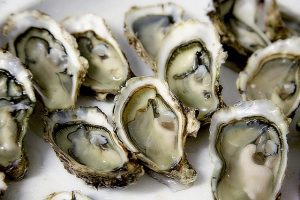Civil War Cookin’: Oysters, Sage, Onion – What To Stuff In A Turkey
 When I think of historical stories about stuffing a turkey, the first one that usually comes to mind is a humorous scene from Laura Ingalls Wilder’s autobiographical novel By The Shores of Silver Lake.
When I think of historical stories about stuffing a turkey, the first one that usually comes to mind is a humorous scene from Laura Ingalls Wilder’s autobiographical novel By The Shores of Silver Lake.
Although set in Dakota Territory well after the Civil War, the story makes me think of the food shortages and culinary longings experienced by civilians and soldiers at certain times during the 1860’s conflict.
Pa came hurrying to the house. “First spring flock of geese’s in sight!” he said. “How about roast goose for dinner?” He hurried away with his gun.
“Mm, it will be good,” Mary said. “Roast goose with sage stuffing! Won’t you like that, Laura!”
“No, and you know I don’t,” Laura answered. “You know I don’t like sage. We’ll have onion in the stuffing.”
“But I don’t like onion!” Mary said crossly. “I want sage!”
Laura sat back on her heels where she was scrubbing the floor. “I don’t care if you do. We won’t have it! I guess I can have what I want sometimes!”
“Why, girls!” Ma said astonished. “Are you quarreling?”
“I want sage!” Mary insisted.
“And I want onion!” Laura cried.
“Girls, girls,” Ma said in distress. “I can’t think what’s got into you. And I never heard of anything so silly! You both know we have no sage, nor onion either.”[i]
 No sage, no onion? How about oysters in the stuffing? While the Ingalls family wouldn’t have had that on the prairie either at that time, oysters are certainly mentioned in Civil War writings and recipes from Thanksgiving celebrations.
No sage, no onion? How about oysters in the stuffing? While the Ingalls family wouldn’t have had that on the prairie either at that time, oysters are certainly mentioned in Civil War writings and recipes from Thanksgiving celebrations.
Mrs. Childs – who compiled a cookbook in the 1830’s – gave some hints for stuffing poultry:
A good sized turkey should be roasted two hours and a half, or three hours; very slowly at first. If you wish to make plain stuffing, pound a cracker, or crumble some bread very fine, chop some raw salt pork very fine, sift some sage, (and summer-savory, or sweet marjoram, if you have them in the house, and fancy them,) and mould them all together, seasoned with a little pepper. An egg worked in makes the stuffing cut better; but it is not wroth while when eggs are dear.[ii]
Though Mrs. Child’s mentions salt pork in the stuffing, oysters had become a popular favorite by the 1860’s for those who could afford the delicacy. Happily, the railroads made oysters available, even to families living far from the coast and canned or frozen shellfish were often shipped during the holidays. Soldiers liked their oysters too, though this specialty food was usually destined for the officers’ mess. However, on some occasions, oysters were captured or foraged and the enlisted men had a treat! For example, John Mosby and his partisans apparently dined on oysters on several occasions after their raids on Union supplies.
We know that Union soldiers got turkeys for Thanksgiving meals, and while stuffing a turkey is not essential, it may have been a tradition that some camp cooks endeavored to keep. One can’t help wondering if hardtack would have been a tolerable substitute for crackers or bread!
 At our house, we don’t usually put the stuffing in the turkey. A little different, I know. We cook it in a casserole dish, and some folks prefer to call it “dressing.” Just sayin’…
At our house, we don’t usually put the stuffing in the turkey. A little different, I know. We cook it in a casserole dish, and some folks prefer to call it “dressing.” Just sayin’…
With that thought in mind, I stumbled across another oyster recipe. Probably when oysters went in the traditional stuffing, they were chopped (like the salt pork), but here’s more of a “dressing” recipe, though Mrs. Child’s calls it “Escaloped Oysters.”
Put crumbled bread around the sides and bottom of a buttered dish. Put oysters in a skillet, and let the heat just strike them through; then take them out of the shells, and rinse them thoroughly in the water they have stewed in. Put half of them on the layer of crumbled bread, and season with mace and pepper; cover them with crumbs of bread and bits of butter; put in the rest of the oysters, season and cover them in the same way. Strain their liquor, and pour over. If you fear they will be too salted, put fresh water instead. Bake fifteen or twenty minutes.[iii]
Whether you choose onion, sage, or oysters for your turkey stuffing (or dressing), we hope there will be no shortage of flavor and historical discussion at your dining table…and no arguments about the seasonings!
Sources:
[i] Laura Ingalls Wilder, By The Shores of Silver Lake, page 244.
[ii] Childs, The American Frugal Housewife, 1833; reprinted by Applewood Books, page 55.
[iii] Ibid, page 120
I love oysters, especially fried in cornmeal, but I know oysters are not as popular as they once were. We always had oyster stew (milk/creme based) for New Years’ Day, and those little tins of smoked oysrers are always in my cabinets. Anyone else out there like oysters?
I grab a tin and enjoy with my lunch on the weekends –